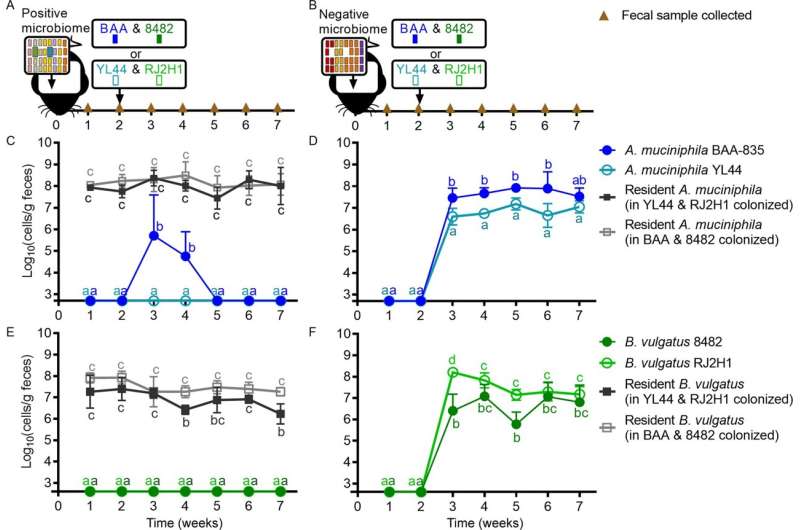A. muciniphila and B. vulgatus strains only colonized gnotobiotic mice harboring complex microbiomes devoid of these species. Experimental design to test colonization of strains in mice harboring a microbiome with (positive; A) and without (negative; B) A. muciniphila and B. vulgatus. Brown triangles represent timepoints for fecal sample collections. Black arrows represent colonization events with microbiomes or A. muciniphila and B. vulgatus strains. Week 2 fecal samples were collected prior to inoculating with test strains. Abundance of A. muciniphila species (gray), strain BAA-835 (dark blue), and strain YL44 (light blue) in mice harboring either a positive (C) or a negative (D) microbiome. Abundance of B. vulgatus species (gray), strain 8482 (dark green), and strain RJ2H1 (light green) in mice harboring either a positive (E) or a negative (F) microbiome. Values are presented as mean ± the standard deviation. Time points with different letters are significantly (p < 0.05) different from one another at indicated timepoints by two-way ANOVA repeated measures and Tukey test multiple pairwise comparisons in each plot. Credit: The ISME Journal (2022). DOI: 10.1038/s41396-022-01208-9
The dense, diverse collection of bacteria and other microorganisms that begin colonizing the human gastrointestinal tract from birth—collectively called the gut microbiome—is known to influence digestion and immune responses. Accumulating evidence hints that the microbiome can sway other systems, too, from the cardiovascular to the nervous.
Researchers are now investigating how to introduce, establish and cultivate bacterial species and strains that can benefit their human hosts. Unfortunately, that's proving more difficult than marketers of kombucha and other alleged probiotics make it seem. One reason: the roughly 100 trillion bacteria already residing in the gut of the average adult. Many recent studies suggest that the long-term survival odds of introduced bacteria can depend on their similarity to the gut's native species and strains—whether they can find their own niche, or whether they must compete for resources with their entrenched counterparts.
In that way, the gut seems to exhibit some of the ecological principles originally observed in forests, grasslands, deserts and oceans. But experimental evidence for those parallels is limited.
Nebraska's Amanda Ramer-Tait, Rafael Segura Muñoz and colleagues put the parallels to the test with germ-free mice, four bacterial strains—two from the species Akkermansia muciniphila, two from Bacteroides vulgatus—and a complex microbiome lacking those species. Across multiple experiments, the team introduced a mixed-species pair of the strains—one A. muciniphila, one B. vulgatus—to the guts of the mice, letting those strains establish themselves for multiple weeks before introducing the other two strains.
The experiments indicated that, much like in larger-scale ecosystems, staking out gut territory before a potential competitor is a critical advantage: Whichever of the A. muciniphila and B. vulgatus strains received a two-week head start on colonizing the gut gained a permanent foothold.
The two species differed, though, when it came to the fates of their late arrivals. The second-arriving B. vulgatus strain still managed to establish a colony, albeit at lower levels than if it arrived first. By contrast, whichever A. muciniphila strain was beaten to the gut failed to survive over the long term. Follow-up analyses revealed that the two A. muciniphila strains shared more genes than did the two B. vulgatus strains. Those B. vulgatus strains also preferred different carbohydrates, further suggesting that they occupy different niches in the gut—and likely explaining why the late arrival could still carve out a permanent place in the ecosystem.
The team then showed that administering an antibiotic to remove the established A. muciniphila strain allowed the other, later-arriving strain to survive and thrive in the gut. That discovery both cemented the importance of ecological niches in the gut and acted as a proof-of-concept for introducing beneficial bacteria to a gut that would otherwise reject them, the researchers said.
Still on the team's to-do list:
- Ascertain why arrival time is so integral to a bacterial strain's long-term prospects in the gut
- Run its experiments with other, gut-relevant strains and in larger, more representative gut ecosystems
- Investigate antibiotic-free methods of removing targeted strains
More information: Rafael R. Segura Munoz et al, Experimental evaluation of ecological principles to understand and modulate the outcome of bacterial strain competition in gut microbiomes, The ISME Journal (2022). DOI: 10.1038/s41396-022-01208-9
Journal information: ISME Journal
Provided by University of Nebraska-Lincoln
























